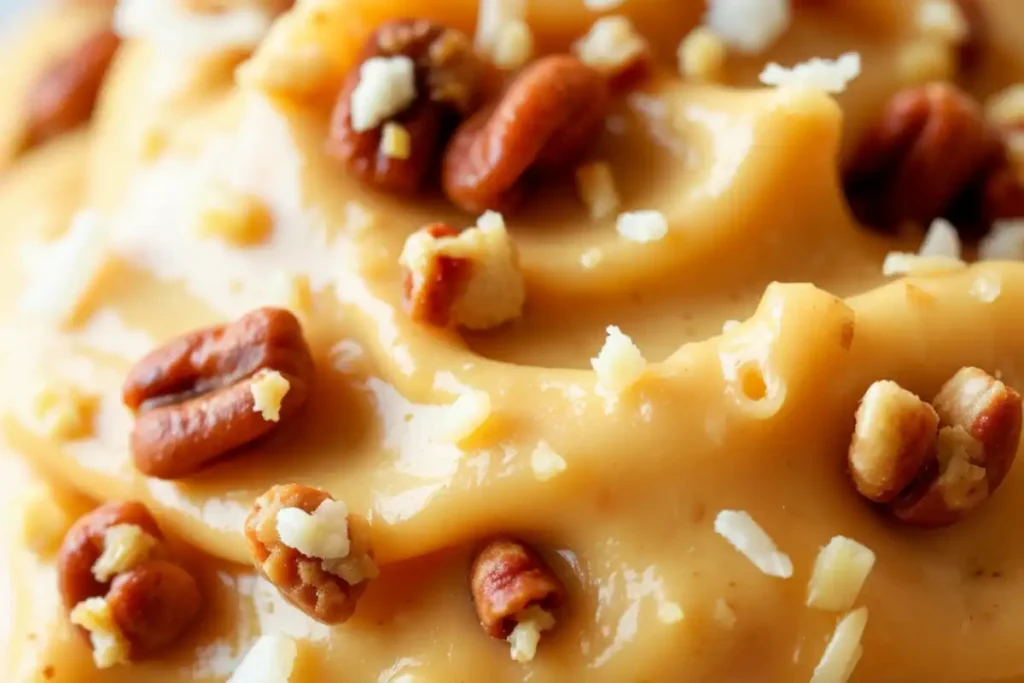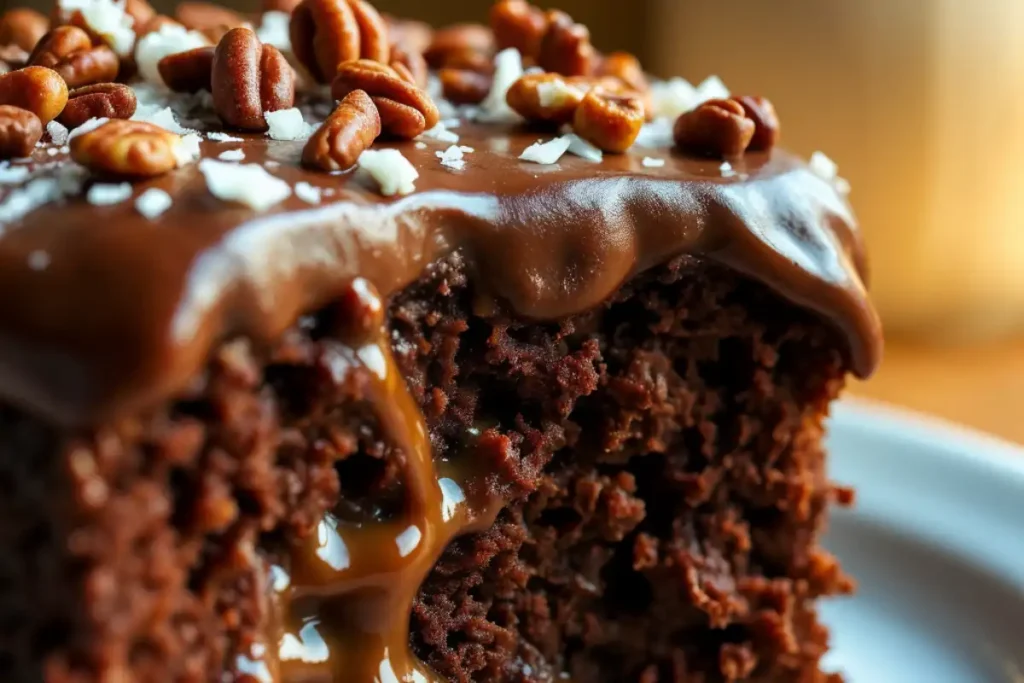German Chocolate Cake holds a unique spot in the world of desserts. It’s known for its rich layers, distinctive frosting, and surprising history. Despite the name, German Chocolate Cake isn’t German at all. This dessert has become a beloved treat in many households, especially in the United States, due to its mild chocolate flavor and signature coconut-pecan frosting. But what really sets this cake apart from other chocolate cakes? Let’s dive into the origins, ingredients, and key characteristics of this cake to understand what makes it so special.
Origin of German Chocolate Cake
It’s easy to assume that German Chocolate Cake originated in Germany, but that’s a misconception. The cake actually takes its name from Samuel German, an American baker and chocolatier. In 1852, German developed a dark baking chocolate for the Baker’s Chocolate Company, which later became the star ingredient in what we now know as German Chocolate Cake. It gained national recognition in 1957 when a recipe using German’s sweet chocolate was published in a Dallas newspaper. Since then, it has remained a staple in American kitchens.
Learn more about the fascinating history of German Chocolate Cake and why people consider it an American invention despite its misleading name.
Ingredients: What Makes German Chocolate Cake Unique?
The primary ingredients that set this cake apart from other chocolate cakes are German’s sweet chocolate and the iconic coconut-pecan frosting
- German’s Sweet Chocolate: Unlike regular chocolate or Baker’s chocolate, which can be bitter, German’s sweet chocolate is milder and slightly sweeter. This chocolate gives the cake a balanced flavor that isn’t overly rich or intense, making it perfect for those who prefer a lighter chocolate taste.
- Coconut-Pecan Frosting: The signature frosting blends egg yolks, evaporated milk, sugar, coconut flakes, and pecans. The frosting cooks until it thickens into a custard-like texture, creating a unique consistency that complements the cake’s light chocolate layers. The combination of crunchy pecans and sweet coconut makes this frosting unlike any other.
Explore more about German’s sweet chocolate and why it’s crucial for achieving the authentic flavor in this cake.
Additionally, if you’re looking for other variations, you might find recipes like German Chocolate Poke Cake interesting. This modern twist on the classic cake incorporates extra moisture and flavor into each bite.
Texture and Flavor Profile
When comparing this dessert to other types of chocolate cake, several differences stand out:
- Texture: The cake layers typically feel light, airy, and not overly dense. Incorporating whipped egg whites helps achieve this texture, making each bite delicate yet satisfying.
- Flavor: Using German’s sweet chocolate results in a mild, sweet chocolate flavor that is more subtle than what you’ll find in cakes made with darker, richer chocolates. The balance between the sweet chocolate and the nutty, coconut-packed frosting creates a delightful contrast that defines this cake.

The Iconic Coconut-Pecan Frosting
The coconut-pecan frosting remains the heart of this dessert. Unlike traditional buttercream or ganache frostings, this one cooks and thickens on the stovetop. A mixture of egg yolks, sugar, evaporated milk, butter, and vanilla is slowly heated until it forms a rich, custard-like consistency. Once thickened, shredded coconut and chopped pecans are added, giving the frosting its distinct flavor and texture.
This frosting stands out because of its slightly caramelized taste combined with the nuttiness from the pecans and the chewiness of the coconut. Traditionally, it’s used not just to top the cake but also as a filling between the layers, ensuring every bite is packed with flavor.
For another cake recipe with a rich frosting experience, check out this delightful Strawberry Crunch Poke Cake Recipe for a unique twist on classic dessert flavors.
Comparison to Other Chocolate Cakes
When comparing this dessert to other types of chocolate cake, several differences stand out due to its specific characteristics:
- Devil’s Food Cake: Known for its deep, dark chocolate flavor, Devil’s Food Cake uses cocoa powder or dark chocolate, resulting in a more intense and less sweet taste. The texture feels denser and richer compared to the light and airy layers of German Chocolate Cake.
- Classic Chocolate Cake: This versatile cake can be made with various chocolates, including milk, dark, or semi-sweet varieties. It typically features a simple buttercream or ganache frosting rather than the complex coconut-pecan topping found in German Chocolate Cake.

These differences make this Cake distinct in both flavor and texture, offering something unique to those who might find other chocolate cakes too heavy or rich.
Variations of German Chocolate Cake
While the traditional recipe remains popular, several variations have emerged over the years:
- Vegan German Chocolate Cake: Substitute traditional ingredients like butter and eggs with plant-based alternatives to create a vegan version.
- Gluten-Free German Chocolate Cake: Using almond flour or gluten-free baking mixes allows those with gluten sensitivities to enjoy this dessert.
- Cupcake Versions: Miniaturizing the cake into cupcakes makes it easier to serve at parties or gatherings, with each cupcake featuring its own dollop of coconut-pecan frosting.
These variations show just how versatile German Chocolate Cake can be while still maintaining its iconic flavor profile.
For a unique take on sweet desserts, try this popular No-Bake Cherry Cheesecake Dessert for a quick and delicious treat.
Popular Serving Suggestions and Occasions
German Chocolate Cake is often served on special occasions, from birthdays to holiday celebrations. Its rich layers and distinctive flavor make it a crowd-pleaser at gatherings. Here are some serving suggestions:
- Serve with a side of vanilla or coconut ice cream to enhance the cake’s flavor.
- Pair with coffee or a sweet dessert wine to complement the cake’s mild chocolate notes.
- Garnish with extra toasted coconut flakes or pecans for added texture and presentation.
FAQs: Common Questions About German Chocolate Cake
Here are some frequently asked questions that people have about German Chocolate Cake:
- Is German Chocolate Cake really from Germany? No, it takes its name from Samuel German, an American baker. The cake is entirely an American creation.
- What makes the frosting unique? The cooked coconut-pecan frosting sets it apart from other cakes, offering a blend of caramelized flavor, nuttiness, and chewiness.
- Can I substitute the ingredients? While you can substitute some ingredients like using different types of chocolate, it’s important to stick to the original frosting ingredients for an authentic taste.
- What type of chocolate is used in German Chocolate Cake? German’s sweet chocolate, a mildly sweet baking chocolate, is traditionally used.
- How can I make a vegan version of this cake? You can replace the butter with plant-based margarine and the eggs with flax eggs or other vegan egg substitutes.
Tips for Baking the Perfect German Chocolate Cake
Achieving the perfect German Chocolate Cake requires attention to detail:
- Use Room Temperature Ingredients: This ensures smooth mixing and a better rise in the cake.
- Don’t Overmix: Be gentle when folding in egg whites to maintain the cake’s light texture.
- Cook the Frosting Slowly: Take your time when cooking the frosting. Low heat and constant stirring prevent curdling and help achieve the right consistency.
By following these tips, you’ll be able to bake a cake that is both delicious and authentic.
Conclusion
This cake remains a classic dessert that has stood the test of time.. Its unique combination of mild chocolate layers and rich coconut-pecan frosting creates a dessert that is truly one-of-a-kind. Whether you stick to the traditional recipe or try a modern variation, this cake is sure to be a hit. So, next time you’re in the mood for a chocolate cake, consider giving German Chocolate Cake a try and enjoy the flavors that have delighted people for decades.

